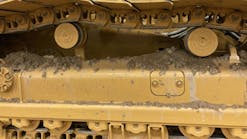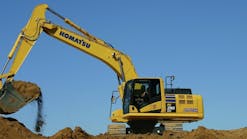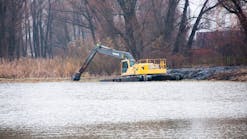Sometimes people are just destined to have the jobs they do. Bruce Steinhauer, a self-proclaimed gearhead, thought his destiny had already found him. For years he had owned an automotive repair shop in Two Rivers, Wis., and had thought little about ever doing anything else. That was until he dropped off a vehicle at a customer's home and saw his first backyard water garden.
The customer was proud of the newly added landscape feature and was happy to show it off. Steinhauer had never been one to get down on his knees to garden or do anything landscape related, so at first he was only mildly intrigued by the customer's water garden and politely listened as his customer enthusiastically told of all its features. A few more minutes into the conversation, Steinhauer found himself asking questions about its construction and before you know it, he was leaving the customer's house with a milk crate full of information about water gardens.
The milk crate sat in the back of Steinhauer's truck until his wife went into labor three days later, and he took it to the hospital for reading material. That day marked the beginning of Steinhauer's new career path. Shortly after the birth of his son, Steinhauer drove to Chicago, picked up a liner and put a pond in the family's backyard. Within a couple of years, Steinhauer found himself constructing water gardens as a side business, and enjoying every minute of it. In 1998, he closed his automotive repair shop and opened Steinie's Water Gardens Unlimited.
Instead of working under cars, Steinhauer now spends his days working in yards. He and his four full-time summer employees specialize in the installation and maintenance of water gardens and irrigation systems. They service both residential and commercial customers, primarily in the Wisconsin counties of Manitowoc and Sheboygan. Steinhauer says at least 20 percent of their business is commercial work. To supplement the water garden and irrigation installation business, Steinhauer has added a retail store and offers snow removal service in the winter.
"It's been a very, very good life-changing experience," says Steinhauer of taking an interest in water garden construction. "I began looking at things from a totally different angle and passion, and there was so much to learn. I found myself just reading book after book and talking to as many people as I could about it."
Learning the ins and outs of water garden construction was paramount to the company's success in the beginning. But even after nearly a decade, Steinhauer will tell you that no two water gardens are the same. There are the basic construction steps of water garden installation, but depending on the size, scope and location of the job, those steps may need to be tweaked and other construction steps added.
Constructing a Water GardenAfter Steinhauer has met with the customer, surveyed the job site, discussed the project, and finalized a design, construction begins. With the first step of the construction process, Steinhauer and his crews dig right in — literally — using the company's Bobcat® 325 compact excavator to dig the hole for the water garden.
Steinhauer says he purchased a compact excavator for his company because of the versatility it provides. The 325 compact excavator's narrow 55-inch width enables Steinhauer's crews to access confined spaces and easily maneuver around obstacles. By using a trenching bucket on the excavator, he says they can quickly and easily excavate the hole and place the spoil where they want it.
To help expedite dirt hauling, Steinhauer recently purchased a Bobcat MT52 mini track loader. He says the compact excavator and mini track loader work in tandem — the excavator dumps the spoil into the bucket attachment of the mini track loader, which then transports and dumps it onto a waiting dump trailer. Unless the job calls for a waterfall or other landscaping features, the dirt from the hole is hauled away. In the past, Steinhauer says his crew members manually transported the dirt by wheelbarrow to the dump trailer. Not only was the old method time consuming and back straining, but it also caused greater ground disturbance, he says.
"For hauling dirt away, the mini track loader works so nicely because we can run it across the grass back and forth and nobody would know that we were there," he says. "When we used the wheelbarrows, we had all that weight on one little area of the wheel. Now with this tracked machine, it's spanned out over a much wider area.
"When we leave, we try our very best to make sure the whole project site is cleaned up better than when we came. And our equipment makes that part of our job so much easier," Steinhauer adds.
Once the dirt is hauled away, the crew installs a thick, felt-like underlayment in the hole before laying down the actual pond lining. After the water garden is lined, they "rock it" or line the entire pond with rocks and stones. In most cases, the mini track loader is used to haul the 4-inch to 8-inch diameter rocks from the dump trailer to the work area, where the compact excavator lifts and places the rocks in the lined pond. During this part of the process, Steinhauer says they'll leave open planting pockets for lilies and marginal plants. Each pond also includes a biological filter to help keep the water clean.
After the pond is filled, Steinhauer says they like to keep the same water in it during the summer, or at the very least, perform minimal water changes. In the spring or fall, they may change the water, but in the summer, says Steinhauer, keeping the same water in the pond helps maintain an ecosystem.
About 50 percent of Steinie's Water Gardens Unlimited customers hire the company to aid in spring startup and fall shutdown of their ponds. But many are able to keep up with the daily and weekly maintenance, which could take as little as 15 to 30 minutes each week. "If it's constructed correctly, it really is a low-maintenance landscaping feature," he says.
Steinhauer estimates that most residential and small commercial water gardens can be constructed in about a week. But some larger commercial projects have taken several weeks or even months to complete. One of the largest commercial projects Steinhauer and his crew have built is a 90,000-gallon water garden in the courtyard of a local insurance company. The Bobcat 325 compact excavator was used to dig the massive pond hole, which measured about 250 by 150 feet and was 5 feet deep.
"We're not afraid to take on a challenge. I can tell you a lot of things not to do. You know, we've made our share of mistakes, but you learn from it and go on from there," Steinhauer says. "I'm not afraid to take a chance and make a mistake."
The transition from running an automotive repair shop to owning and operating a water garden installation company was definitely a life-altering challenge for Steinhauer to take on. Judging from the longevity and success of his company, he's made very few mistakes.




